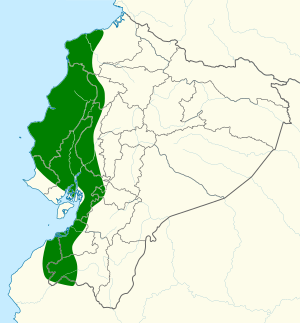Ecuadorian trogon facts for kids
Quick facts for kids Ecuadorian trogon |
|
|---|---|
 |
|
| Conservation status | |
| Scientific classification | |
| Genus: |
Trogon
|
| Species: |
mesurus
|
 |
|
| Synonyms | |
|
|
The Ecuadorian trogon (scientific name: Trogon mesurus) is a beautiful bird that belongs to the trogon family. This family also includes the famous quetzals. You can find this colorful bird living in the countries of Ecuador and Peru.
Contents
What's in a Name? The Ecuadorian Trogon's Story
The Ecuadorian trogon has had a few different scientific names over time. Before its current name, it was thought to be a type of black-tailed trogon. But in the early 2000s, scientists did some special genetic studies. These studies showed that the Ecuadorian trogon is actually its own unique species. This means it is monotypic, having no subspecies.
Meet the Ecuadorian Trogon: Appearance
The Ecuadorian trogon is a medium-sized bird, about 30.5 to 32 centimeters (12 to 12.5 inches) long. A male trogon can weigh around 96 grams (3.4 ounces). Females are a little heavier, weighing about 100 grams (3.5 ounces).
Male Trogon Colors
Male Ecuadorian trogons have a striking look. Their face and throat are black. They have a bright red ring around each eye. The top of their head, neck, and upper body are a shiny, iridescent green. This green color also covers their upper chest. A clear white band separates their green upper chest from their deep red lower chest and belly. The top of their tail is green, while the underside is a slaty gray color. When their wings are folded, you can see fine black and grayish-white patterns on them.
Female Trogon Colors
Female Ecuadorian trogons are also beautiful, but their colors are a bit different. Instead of the bright green parts seen on the male, the female has shades of gray. This helps them blend in with their surroundings.
Where Do They Live? Distribution and Habitat
The Ecuadorian trogon lives in a specific part of South America. You can find them starting from the northernmost province of Ecuador, called Esmeraldas. From there, their home stretches south into Lambayeque Province in Peru.
Their Forest Home
These birds prefer to live in humid forests. They can be found both at the edges of these forests and deep inside them. They like evergreen forests, which stay green all year. They also live in semideciduous forests, where some trees lose their leaves during certain seasons. In Ecuador, you might see them from sea level up to about 2,000 meters (6,560 feet) high. In Peru, they usually live between 400 and 1,250 meters (1,300 to 4,100 feet) in elevation.
How Do They Live? Behavior
Scientists are still learning a lot about the Ecuadorian trogon's daily life.
What Do They Eat? Feeding Habits
We don't have many studies specifically on what the Ecuadorian trogon eats. However, we can guess based on how other trogons behave. Most trogons are known to "sally" from a perch. This means they sit still on a branch, then quickly fly out to grab food. They usually pluck fruits or insects, like arthropods, from plants.
Building a Home: Breeding Habits
The nests of the Ecuadorian trogon are quite interesting. The only nests ever described were found inside active arboreal termitaria. These are large nests built by termites in trees. The trogons dig out a cavity inside these termite nests. Each nest usually holds three eggs. Both the male and female trogon take turns sitting on the eggs to keep them warm until they hatch.
Their Voice: Vocalization
The song of the Ecuadorian trogon is easy to recognize. It's a slow series of "cow" notes. The song often starts quietly and then gets louder, like "cuh-cuh-cuh-cuh-cow-cow-ców-ców-ców." Both male and female trogons also make a special call. This call is a fast series of churring sounds, like "crra crra crra crra."
How Are They Doing? Conservation Status
The IUCN (International Union for Conservation of Nature) keeps track of how well different species are doing. They have listed the Ecuadorian trogon as a species of Least Concern. This is good news! It means that the bird is not currently in danger of disappearing.
Protecting Their Home
Even though their population size hasn't been counted exactly, scientists believe it is stable. However, like many other birds that live in forests, the Ecuadorian trogon faces a challenge. They are vulnerable to their habitat being lost or damaged. This can happen if forests are cut down or changed. Protecting their forest homes is important to keep these beautiful birds safe for the future.
See also
 In Spanish: Trogón ecuatoriano para niños
In Spanish: Trogón ecuatoriano para niños


